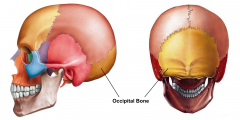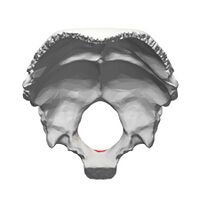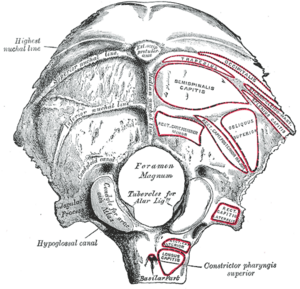Occipital Bone: Difference between revisions
No edit summary |
Kim Jackson (talk | contribs) No edit summary |
||
| (19 intermediate revisions by 5 users not shown) | |||
| Line 1: | Line 1: | ||
<div class="editorbox"> | <div class="editorbox"> | ||
'''Original Editor''' | '''Original Editor'''- [[User:Hannah Hassell|Hannah Hassell]] | ||
'''Top Contributors''' - {{Special:Contributors/{{FULLPAGENAME}}}} | '''Top Contributors''' - {{Special:Contributors/{{FULLPAGENAME}}}} | ||
</div> | </div> | ||
== Description == | == Description == | ||
[[File:Occipital_bone.png|alt=|right|240x240px]] | |||
The Occipital bone is a trapezoidal-shaped [[bone]] forming the base of the [[Bones of the skull|skull]]. It is situated at the the lower and back part of the cranium. The large oval opening in the bone is called the foramen magnum through which the [[Spinal cord anatomy|spinal cord]] exits the cranial vault. | |||
[[File:Occipital_bone.png| | |||
=== Articulations === | === Articulations === | ||
[[File:Fullsizeoutput_c1.jpeg|200x200px|alt=|thumb|Occiput bone from above]]The occipital bone articulate with six bones: | |||
* Two temporal bones | |||
* Two parietal bones | |||
* Sphenoid bone | |||
* [[Atlas]] | |||
=== Muscle | === Muscle Attachments === | ||
[[File:Occiput attachments.png|thumb|Muscle attachments]] | |||
# Superior curved line: Occipito frontalis; [[Trapezius]]; [[Sternocleidomastoid]] | |||
# Space between the curved lines: Complexus; [[Splenius Capitis|Splenius capitis]]; Obliquus superior | |||
# Inferior curved line and space between it and the foramen magnum: Rectus posticus major and minor | |||
# Transverse process: Rectus lateralis | |||
# Basilar process: Rectus antics major and minor; Superior constrictor of pharynx<ref>Gray H, Anatomy, descriptive and surgical, 8th edition, Philadelphia, Collins, June, 1878</ref> | |||
== | == Clinical Relevance == | ||
Basilar skull fracture | |||
== See | == See Related Research == | ||
Occipital neuralgia<ref>Dougherty, C. Curr Pain Headache Rep (2014) 18: 411. <nowiki>https://doi-org.uplib.idm.oclc.org/10.1007/s11916-014-0411-x</nowiki></ref> | |||
= References = | = References = | ||
<references /> | <references /> | ||
[[Category:Anatomy]] [[Category:Bones]] | [[Category:Anatomy]] | ||
[[Category:Bones]] | |||
[[Category:Head - Anatomy]] | |||
[[Category:Head - Bones]] | |||
[[Category:Head]] | |||
Latest revision as of 12:17, 3 February 2022
Original Editor- Hannah Hassell Top Contributors - Mande Jooste, Hannah Hassell, Kim Jackson, Lucinda hampton and Tony Lowe
Description[edit | edit source]
The Occipital bone is a trapezoidal-shaped bone forming the base of the skull. It is situated at the the lower and back part of the cranium. The large oval opening in the bone is called the foramen magnum through which the spinal cord exits the cranial vault.
Articulations[edit | edit source]
The occipital bone articulate with six bones:
- Two temporal bones
- Two parietal bones
- Sphenoid bone
- Atlas
Muscle Attachments[edit | edit source]
- Superior curved line: Occipito frontalis; Trapezius; Sternocleidomastoid
- Space between the curved lines: Complexus; Splenius capitis; Obliquus superior
- Inferior curved line and space between it and the foramen magnum: Rectus posticus major and minor
- Transverse process: Rectus lateralis
- Basilar process: Rectus antics major and minor; Superior constrictor of pharynx[1]
Clinical Relevance[edit | edit source]
Basilar skull fracture
See Related Research[edit | edit source]
Occipital neuralgia[2]









